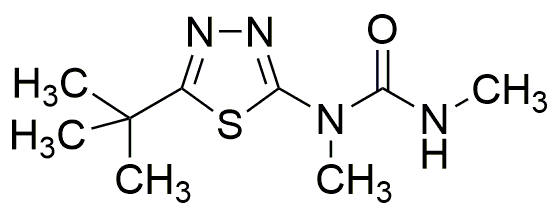Tebuthiuron is widely utilized in research focused on:
- Agricultural Weed Control: This chemical is primarily used as a herbicide to manage unwanted vegetation in crops, particularly in non-crop areas like roadsides and railways. Its effectiveness in controlling perennial weeds makes it a valuable tool for farmers and land managers.
- Forestry Management: In forestry, tebuthiuron helps in the selective control of invasive plant species, promoting the growth of desirable trees and enhancing biodiversity. This application is crucial for maintaining healthy forest ecosystems.
- Environmental Restoration: The compound is employed in ecological restoration projects to clear invasive species, allowing native plants to thrive. This is particularly important in areas where ecosystems have been disrupted.
- Research in Plant Physiology: Scientists use tebuthiuron to study plant responses to herbicides, providing insights into plant metabolism and resistance mechanisms. This research can lead to the development of more effective and sustainable agricultural practices.
- Soil Management Practices: Tebuthiuron is also applied in soil management to improve crop yields by controlling weeds that compete for nutrients and water. This application is beneficial for enhancing agricultural productivity.
General Information
Properties
Safety and Regulations
Applications
Tebuthiuron is widely utilized in research focused on:
- Agricultural Weed Control: This chemical is primarily used as a herbicide to manage unwanted vegetation in crops, particularly in non-crop areas like roadsides and railways. Its effectiveness in controlling perennial weeds makes it a valuable tool for farmers and land managers.
- Forestry Management: In forestry, tebuthiuron helps in the selective control of invasive plant species, promoting the growth of desirable trees and enhancing biodiversity. This application is crucial for maintaining healthy forest ecosystems.
- Environmental Restoration: The compound is employed in ecological restoration projects to clear invasive species, allowing native plants to thrive. This is particularly important in areas where ecosystems have been disrupted.
- Research in Plant Physiology: Scientists use tebuthiuron to study plant responses to herbicides, providing insights into plant metabolism and resistance mechanisms. This research can lead to the development of more effective and sustainable agricultural practices.
- Soil Management Practices: Tebuthiuron is also applied in soil management to improve crop yields by controlling weeds that compete for nutrients and water. This application is beneficial for enhancing agricultural productivity.
Documents
Safety Data Sheets (SDS)
The SDS provides comprehensive safety information on handling, storage, and disposal of the product.
Product Specification (PS)
The PS provides a comprehensive breakdown of the product’s properties, including chemical composition, physical state, purity, and storage requirements. It also details acceptable quality ranges and the product's intended applications.
Certificates of Analysis (COA)
Search for Certificates of Analysis (COA) by entering the products Lot Number. Lot and Batch Numbers can be found on a product’s label following the words ‘Lot’ or ‘Batch’.
*Catalog Number
*Lot Number
Certificates Of Origin (COO)
This COO confirms the country where the product was manufactured, and also details the materials and components used in it and whether it is derived from natural, synthetic, or other specific sources. This certificate may be required for customs, trade, and regulatory compliance.
*Catalog Number
*Lot Number
Safety Data Sheets (SDS)
The SDS provides comprehensive safety information on handling, storage, and disposal of the product.
DownloadProduct Specification (PS)
The PS provides a comprehensive breakdown of the product’s properties, including chemical composition, physical state, purity, and storage requirements. It also details acceptable quality ranges and the product's intended applications.
DownloadCertificates of Analysis (COA)
Search for Certificates of Analysis (COA) by entering the products Lot Number. Lot and Batch Numbers can be found on a product’s label following the words ‘Lot’ or ‘Batch’.
*Catalog Number
*Lot Number
Certificates Of Origin (COO)
This COO confirms the country where the product was manufactured, and also details the materials and components used in it and whether it is derived from natural, synthetic, or other specific sources. This certificate may be required for customs, trade, and regulatory compliance.

